 Florida’s Reading test results in the National Assessment for Education Progress (NAEP) weren’t all bad news, but things look much worse for Math scores.
Florida’s Reading test results in the National Assessment for Education Progress (NAEP) weren’t all bad news, but things look much worse for Math scores.
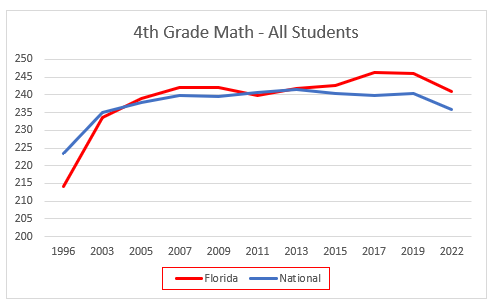 Where Florida’s fourth-grade Reading test scores dropped by an average of 0.6 points across all subgroups, students lost an average of 5.2 points in fourth-grade Math. The results were even worse for eighth graders.
Where Florida’s fourth-grade Reading test scores dropped by an average of 0.6 points across all subgroups, students lost an average of 5.2 points in fourth-grade Math. The results were even worse for eighth graders.
It’s worth noting that Florida’s declines in NAEP Math scores mirrored the declines seen in the national average, but that average is both richer and whiter. When adjusting for race and income, Florida tends to dominate the national rankings, while Florida’s Reading performance tops the charts.
Despite being a majority-minority state – Florida has a larger than average low-income student population – the state’s fourth-grade students beat the national average in Math. Florida’s learning loss was about the same as the national average, with students losing 5.1 points compared to a 4.6 decline nationally, the equivalent of losing about a half year of learning.
Florida’s white fourth-grade students lost 1.1 points compared to 3.1 points nationally.
 Unlike the more uniform learning losses for Reading, Florida’s minority students saw a larger learning loss in Math than white students. Fourth-grade Hispanic students in Florida and nationally lost about the same 6.4 points compared to 6.5 points.
Unlike the more uniform learning losses for Reading, Florida’s minority students saw a larger learning loss in Math than white students. Fourth-grade Hispanic students in Florida and nationally lost about the same 6.4 points compared to 6.5 points.
Black students in Florida lost 7.5 points compared to 7.4 points nationally. Both Black and Hispanic students lost about a half year of learning according to the fourth-grade math scores.
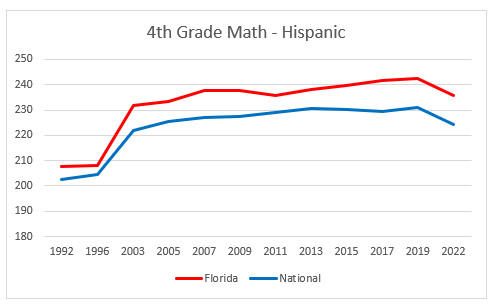
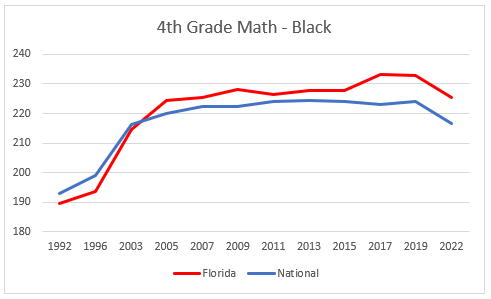 Low-income students, defined as students eligible for free or reduced-priced lunches, saw a 6-point learning loss compared to 6.2 nationally. Overall, Florida’s low-income students still score 10 points more -- about a grade level higher -- than their counterparts nationally.
Low-income students, defined as students eligible for free or reduced-priced lunches, saw a 6-point learning loss compared to 6.2 nationally. Overall, Florida’s low-income students still score 10 points more -- about a grade level higher -- than their counterparts nationally.
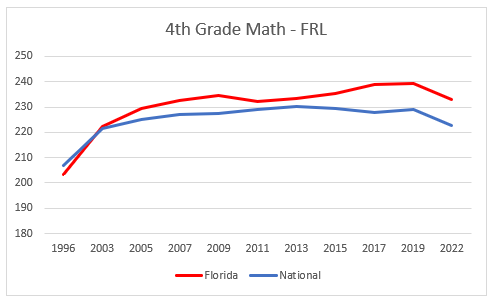 Research shows that without a strong foundation in early grades, older students have to play catch up. That is true with Florida. The state’s overall student population is now about 3 points behind the national average.
Research shows that without a strong foundation in early grades, older students have to play catch up. That is true with Florida. The state’s overall student population is now about 3 points behind the national average.
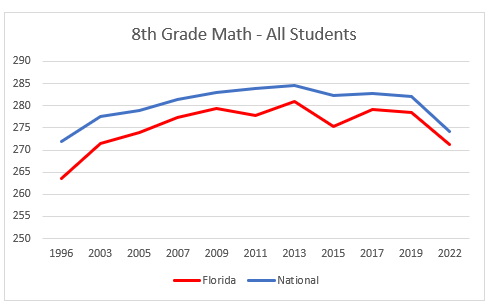 Students nationally saw a slightly larger decline at 7.7 points of learning loss compared to 7.3 points in Florida. A 7- to 8-point decline means students lost almost a year’s worth of learning between 2019 and 2022.
Students nationally saw a slightly larger decline at 7.7 points of learning loss compared to 7.3 points in Florida. A 7- to 8-point decline means students lost almost a year’s worth of learning between 2019 and 2022.
Florida’s white eighth-grade students perform below the national average in Math. Florida students saw a 7.3-point decline compared to 7.6-point decline compared to the national average.
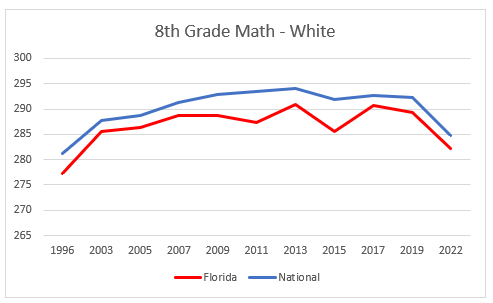 Florida’s black students performed slightly better than their peers nationally and lost 4.6 points compared to 6.8 points nationally.
Florida’s black students performed slightly better than their peers nationally and lost 4.6 points compared to 6.8 points nationally.
Hispanic students also performed better than their peers nationally, scoring about half a grade higher. However, Florida’s Hispanic eighth-grade student population lost 8.8 points compared to 6.8 points nationally.
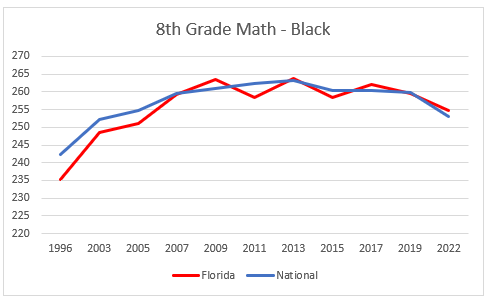
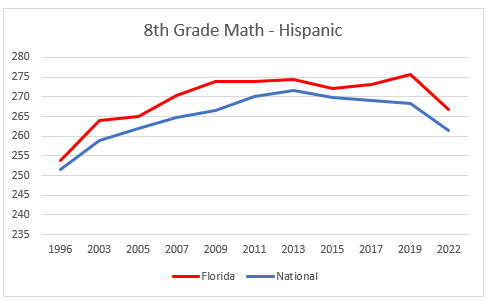 Eighth graders eligible for free or reduced-priced lunch barely edge out the national average in raw scores and in learning losses. Florida’s low-income eighth graders lost 5.6 points compared to 6.7 points nationally.
Eighth graders eligible for free or reduced-priced lunch barely edge out the national average in raw scores and in learning losses. Florida’s low-income eighth graders lost 5.6 points compared to 6.7 points nationally.
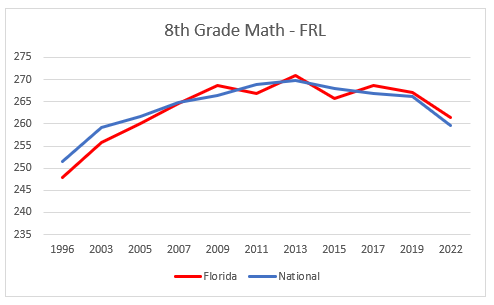 Florida students tended to have smaller learning losses than the national average. Low-income and minority students in Florida also tended to perform better than their peers nationally.
Florida students tended to have smaller learning losses than the national average. Low-income and minority students in Florida also tended to perform better than their peers nationally.
Looking at raw scores, Florida bests the national average in 8 out of the 10 subgroups examined above. Only eighth grade students overall and eighth grade white students lose out to the national average. The national average, however, shows stronger learning gains between fourth and eighth grades.
 Subgroups nationally have nearly a difference of four grades in learning between fourth and eighth grade, while Florida tends to have about a three grade level difference.
Subgroups nationally have nearly a difference of four grades in learning between fourth and eighth grade, while Florida tends to have about a three grade level difference.
Overall, viewing Florida’s fourth and eighth grade math scores confirms that the state does a great job educating students in early grades, but the rest of the nation is able to catch up by the time students reach eighth grade.
 The classic arcade game Punch-Out!! asked players to assume the role of a green-haired boxer named “Little Mac” to box with much larger opponents, like the terrifying Bald Bull. Despite his tiny size, Little Mac could sometimes do things like this to much larger opponents:
The classic arcade game Punch-Out!! asked players to assume the role of a green-haired boxer named “Little Mac” to box with much larger opponents, like the terrifying Bald Bull. Despite his tiny size, Little Mac could sometimes do things like this to much larger opponents:
https://thumbs.gfycat.com/DelightfulNastyAcornbarnacle-small.gif
The story I would like to tell today features my home state of Arizona playing the role of Little Mac in the recent U.S. News & World Report high school rankings to much larger states, including Florida. (Florida, however, has a secret punch in its arsenal – more on that below.)
So: Here is the Little Mac story.
Two Arizona high schools made the top 10 in the recent U.S. News national rankings and 11 made the top 100. While Arizona comprises only 2 percent of the students in the United States, it boasts 11 percent of the top 100 high schools. California, the nation’s most populous state with a public-school system enrolling 6.2 million students (compared to our 1.2 million), tied Arizona with 11 schools in the top 100. Mega-states Texas and New York also landed 11 schools in the top 100 and Florida had 10. No other state scored in the double digits.
“Punching above our weight” would not be an overstatement to describe Arizona’s results in both state and national achievement measures. But … not so fast, my friend!
College credit by exam features very prominently in the rankings, which is fine to include, but it’s not a terribly broad measure. The U.S. News & World Report methodology judges individual schools, but the number of schools making a national top 100 list is a very narrow measure. Our friends at ExcelinEd utilize charts like the one below that show broad statewide improvement in students earning credit by exam in Florida:
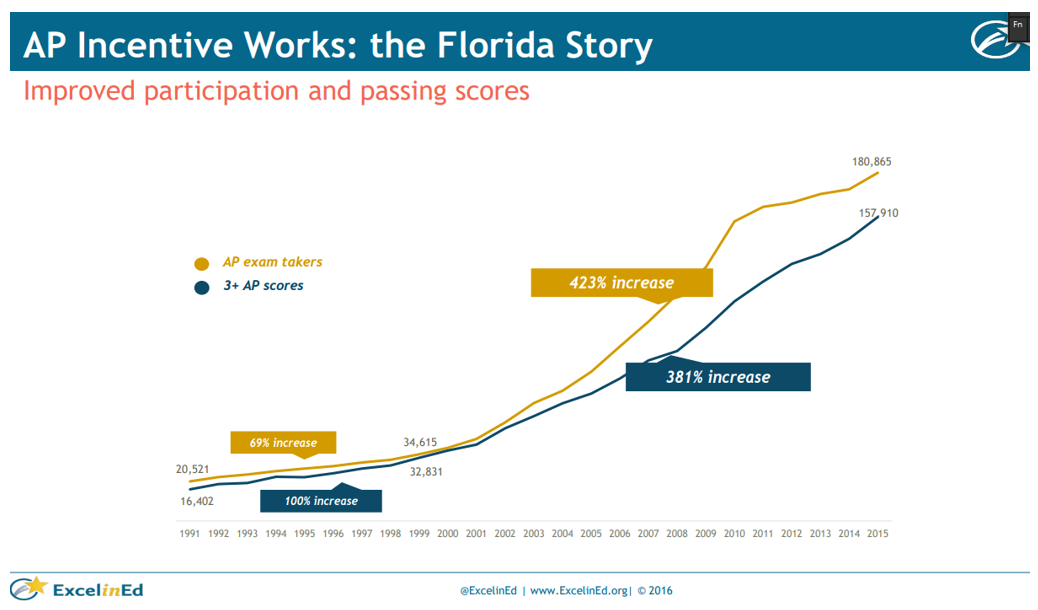
Moreover, there is no reason for high school rankings to credit schools for earning college credit by exam and not for earning high-demand professional certifications. High schools should prepare students for success in college or a career (or both), but how to reach that decision should be made by students and their families. Schools that equip students with high-demand certifications deserve credit as well, in my opinion.
This is not an either-or proposition. Students earning industry certifications often graduate from college. Students earning college credit by exam don’t always finish college and could have benefited from a back-up plan. Ideally, schools would both prepare students to master college-level work and give them the opportunity to earn certifications with value in the labor market.
Florida pioneered a set of policies to encourage schools to earn college credits and later launched a similar effort to encourage high schools to allow students to earn high-demand certifications. If I were ranking high schools, unlike U.S. News & World Report, I’d rank such things equally.
Here is ExcelinEd’s chart showing trends in certifications among Florida high school students.
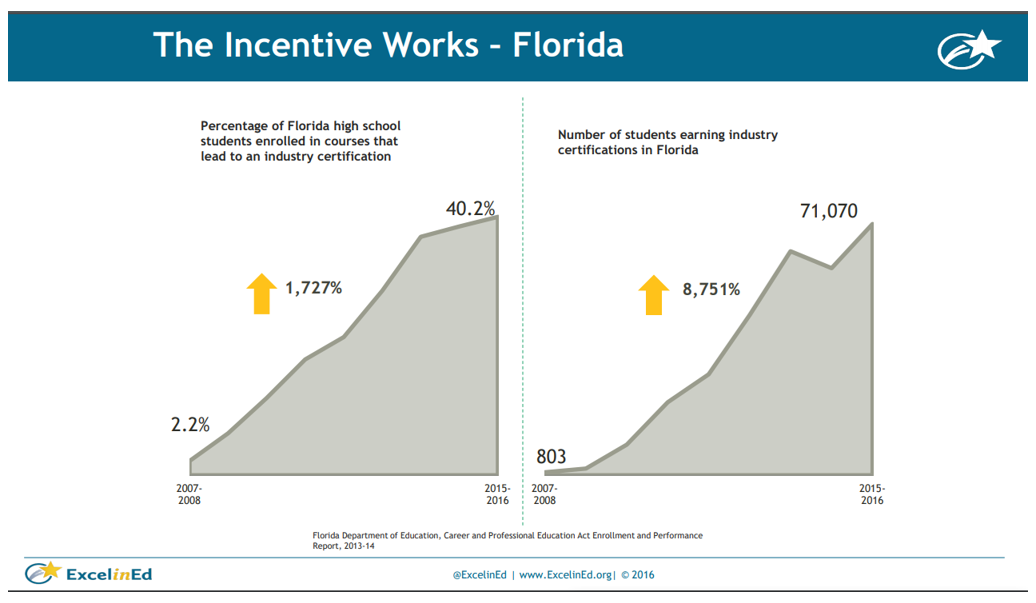
It appears that in addition to 158,000 passing scores on college credit exams in 2015, Florida high school students earned more than 71,000 certifications. By the way, 166,540 students graduated from Florida public schools at the conclusion of the 2015-16 academic year. We can therefore safely assume that a majority of Florida students either earned college credit by exam or earned a certification in a high demand field – or accomplished both.
So, how would U.S. News and World Report rankings for other states look if certifications were included in the rankings? We can’t be sure, but here’s a guess.
https://gfycat.com/ornerypowerlessazurewingedmagpie

![]() In a statement released Wednesday by the U.S. Department of Education, Secretary of Education Betsy DeVos called 2019 NAEP results “devastating,” opining that the country is in a “student achievement crisis” that has continued to worsen over the past decade.
In a statement released Wednesday by the U.S. Department of Education, Secretary of Education Betsy DeVos called 2019 NAEP results “devastating,” opining that the country is in a “student achievement crisis” that has continued to worsen over the past decade.
While the results aren’t great, they’re not quite that bad. One bright spot is that Florida maintains high rankings when adjusting for demographics.
Florida ranks first in fourth-grade reading, first in fourth-grade math, third in eighth-grade reading and eighth in eighth-grade math, according to the Urban Institute’s adjustment of rankings for race, income and English language learner status – and maintains those rankings despite drops in scores for students in the Sunshine State. Nevertheless, those declines are worth exploring.
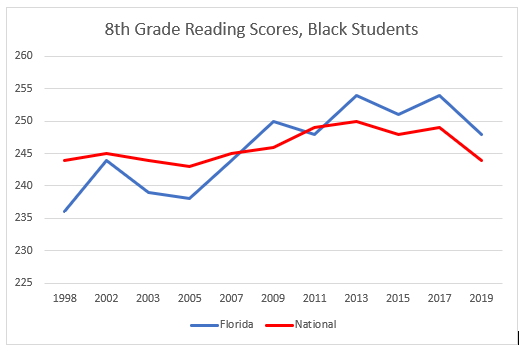
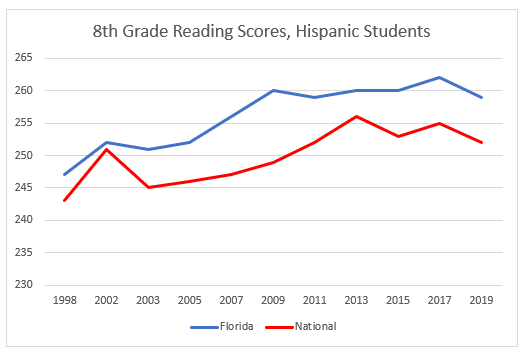
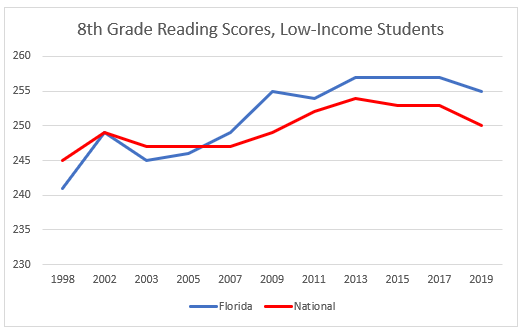
Florida’s fourth-grade reading dropped 3 points, with Hispanic students seeing a 4-point decline and low-income students seeing a 3-point decline. Eighth-grade reading dropped 4 points, with black and Hispanic students dropping 6 and 3 points, respectively. Florida’s overall eighth-grade reading scores tie the national average, consistent with last year’s scores.
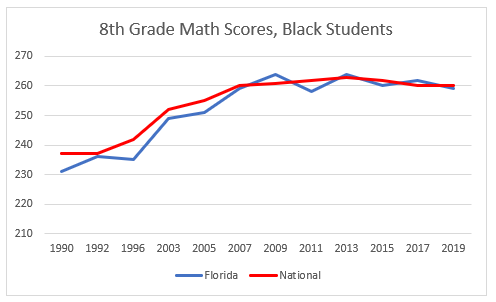
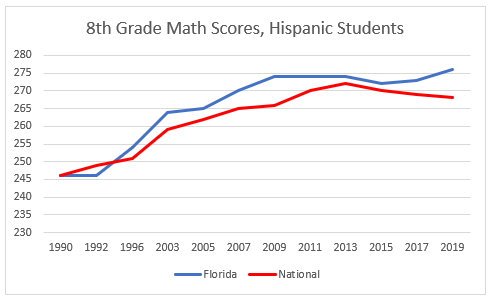

Florida maintained its scores in fourth-grade math and eighth-grade math, however black students declined 3 points while eighth-grade Hispanic students improved by 3 points. Florida’s eighth-grade black students scored at the national average relative to their peers, while Hispanic students maintained a healthy 8-point lead. Florida’s eighth-grade Hispanic math students are the state’s lone bright spot within the 2019 NAEP results.
As the charts show, Florida’s results in 2019 are still far beyond where Florida students started back in 1998, despite the decline.